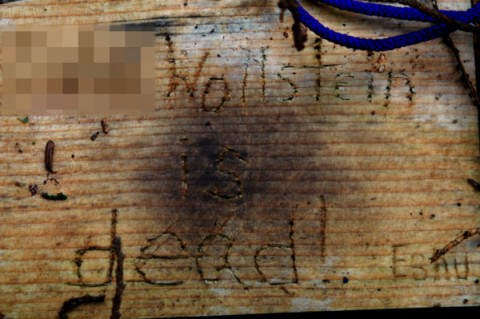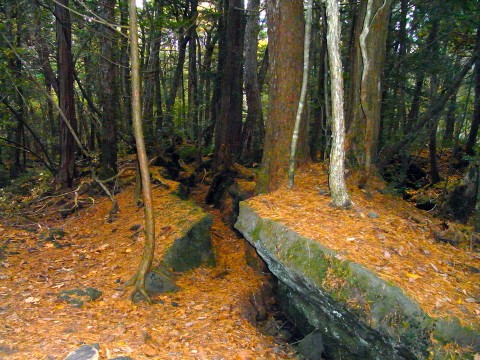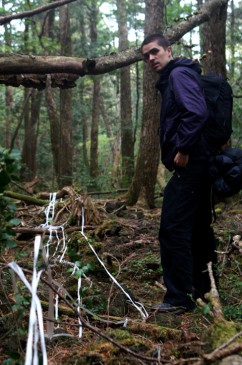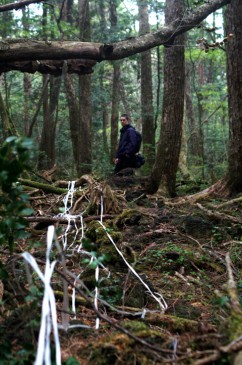Posted by Shane Berry on 06/09/2011
The Aokigahara Jukai is is pure virgin forest estimated to be a little over 1000 years old. It lies on the western slopes of Fuji in the only area not covered with ash and lava in her last known eruption in 1707.
Boxwood, White Cedar and Pine are knotted onto an ancient lava flow which geologists believe flowed into the surrounding valleys and dammed up rivers to create the 5 lakes dotted around Fujisan`s base, like the discarded shards of a vanity mirror. From the air, it looks like a vicious bruise on the skin of a fair maiden, as if an angry god has kicked Fuji in the ribs and smashed her looking glass to pieces.
Part 4 of 4 – The Next Day.
It’s a twisted place. The ground, solidified uneven magma covered with a thin layer of ash and wind blown sand, provides no real purchase for the trees, so they have turned on each other to gain a foothold on life. Peering into the forest is like peering back into a primordial past which is at once startlingly familiar and quietly alien. Something about the place is intangibly—wrong. It seems to be an amalgamation of, and a visual representation of, the struggle of life against all odds, a mad and primal grab for survival at any cost. All the trees are fighting in a slow motion tangle that, if sped up, would most probably resemble a scene of panic on a burning ship, people of all shapes and sizes clawing scratching and tearing their way over blackened corpses and dying passengers to reach the life boats and to save themselves above all others. The floor is strewn with twisted and defeated trunks rotting in the darkness below the canopy. Larger trees, fallen over in the irony of their success, too large and heavy to remain upright in such shallow ground, lean at curious angles, their exposed roots ripping at the ground like desperate fingers searching for a hold, their weight dragging other trees over with them and crushing everything in their way. Vine like roots snare your feet as you walk, and occasionally your foot punches through the carpet of debris and you realize that it is not the ground you are walking on half the time but a network of roots, branches and pine needles sometimes a good two meters above collapsed holes and gullies. Grabbing limbs for support is an exercise in futility, they pull out of the ground like rotten bones from their sockets and this too is an easy way to die, twisting an ankle in a hole and dying from exposure is a common way to go in the heart of the forest.
Bluish black protrusions of rock poke through the ground at all angles like bad teeth in a mouth gone all wrong. And the Jukai often bites. Beneath these jagged canines and molars laces a network of lava tunnels and fissures that on occasion collapse under the weight of the trees above and send areas, sometime tens of metres across, crashing five or six metres into the cavities below. Apparently many hikers venturing deeper into the forest have gone missing in this way, unstable ground swallowing them whole, and they have never been seen again.
It is a dangerous place to wander around, even in groups and a magnetic compass is useless in the forest so it is easy to get lost, really lost, really easily.
That is why many Japanese people come here to die.
In 2003 after the winter snows subsided 75 discovered bodies were pulled out of the forest alone. It is estimated that there are tens if not hundreds more never found. And the number is increasing each year. So much so that the local authorities are burdened with space to store all the bodies and with the financing to do so.
Suicide is a huge economic blow to the area.
At the end of each winter teams of policemen and volunteers with dogs scour the forest for suicides and trim away the twine and string crisscrossing this way and that through the forest.
Because compasses don’t work in the forest, volunteers, body hunters, curious cats, adventurous explorers, group suicides and any other souls lured into the depths of the blue tangle, tie string to the nearest tree and trail it behind them like Jason entering the Minotaur`s maze. Some go in to get a glimpse of the beast, some to confront the beast, and most to lay at its feet in sacrifice.
There are signs posted along the tourist path that ask people to be on the look out for anyone walking in the forest alone, and to report to the local authorities any person who looks depressed or unhappy. Some of the signs make direct urges to suicides to think of their families and the consequences of what they are planning to do—and plan they do. Website forums abound in which people discuss the best areas to die and the best ways to shuffle off this mortal coil. There is also a suicide manual which has seen sales in excess of 1.5 million and in it is detailed the most effective ways to end one`s own life.
Some religious groups have their signs up too, pleading with would be suicides to reconsider life with what ever path they have on offer but the signs themselves are rusted and covered with grime as if the forest has taken possession of these warnings too and is trying to hide them.
It seems to like to possess things.
Strewn throughout the forest are the belongings of travelers and suicides alike: tattered sleeping bags, fungified futons, dirty day packs, empty suicide kits, and odd pieces of paraphernalia and brick-a-brack that at once bring a humanity to the place and yet are totally incongruous in the twisted mess they lie in. Is it a mirror of how these people feel when the lie down to die or rope themselves to hang? Do they feel like incongruous bits and pieces discarded in a twisted world?
Is this place the closest parallel they have to the psychological state they are in when they die – twisted, dark and uncared for, littered with empty vessels and tangled strings?
I would tell of the sweet corn flavored soft cream we ate near the ice caves we snuck into the night before, and of how we got completely disoriented several heart stopping metres from the pathway while exploring the forest in the daylight. I would recount the easy hitchhike home to Tokyo and the great food we ate at The Solar Caf̩ before we set off Рbut some part of me wants to leave the story open here, because in many ways I have never really left the forest at all, and many never do.
Aokigarajukai, the sea of blue foliage, lurks in my thoughts, a shadow in the corner of my mind’s eye. It is a terrible thing that draws people in and wastes them in the horror of it`s primordial chaos. It’s a psychological sore tooth one prods incessantly because it hurts and at the same time relieves the pain.
It is said that the nothing should be taken out of the forest, but does that include the memories it strings up in the psyche of those who venture within?
Part 1Â /Part 2Â /Part 3/Â Part 4
Photos by Levi Rinker
Comments
Leave a Reply
You may use these HTML tags and attributes: <a href="" title=""> <abbr title=""> <acronym title=""> <b> <blockquote cite=""> <cite> <code> <del datetime=""> <em> <i> <q cite=""> <s> <strike> <strong>
*
*







Be the first to comment.